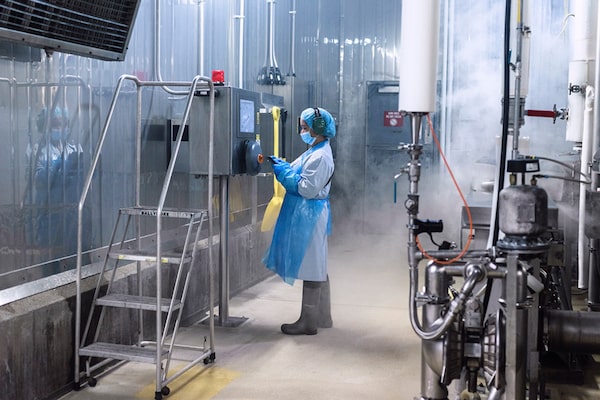
Distribution supervisor Bianca Calimlim monitors a line-visualization station, part of Maple Leaf Foods 'digital future' campaign.Mark Sommerfeld
In the meat-processing plants of Maple Leaf Foods, a company rocked by a deadly listeriosis outbreak in 2008, strict sanitary procedures are ever present. Just crossing the plant floor could take 15 minutes or more because workers and visitors are constantly required to remove protective coveralls and wash down as they traverse the facility.
For production supervisors, the rules meant lots of lost time – up to two hours a day – as they shuttled between the plant floor and their offices to manually enter time-sensitive operational data. All those productivity leaks disappeared last fall when the company gave supervisors iPads to scan and record data, such as equipment maintenance readings and inventory levels, directly into the system. The company’s food safety and quality assurance staff will soon be outfitted with similar devices to record inspection results.
Maple Leaf Foods has also deployed sensors that continuously measure plant humidity and temperature, then analyze those readings to alert personnel to food safety risks, such as inadequate ventilation or lengthy wait times for trucks carrying raw meat into the processing plants.
These moves are merely the most visible elements of a company-wide “digital future” campaign focused on deploying technologies that improve food safety and streamline operations, says chief information officer Andreas Liris.
In a sector where food inspection now means being able to trace any item from the supermarket shelf to the source, Maple Leaf and others already use barcodes and scanners to track origins of ingredients. Next year, however, Maple Leaf will start a pilot project to use predictive algorithms on food safety data.
By accelerating the transfer of plant-floor information to its enterprise-wide systems, says Liris, the company expects to improve not only safety and production, but speed up the process for re-ordering raw materials and ingredients, and boost efficiency in how it sources its raw materials. “We live in a very complex supply chain,” he says, “and having timely and up-to-date information is super important.”
More from Factory of the Future
How to build a smarter factory
Your underwear is watching you
Intelligent robots customize car seats on the fly